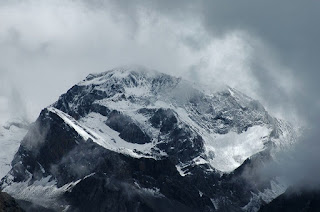Mount Kailash: A Sacred Yet Another Unsolved Mystery
Hello folks, once again I am here with an interesting topic. However, today's topic is a bit different from my previous ones. Today I am going to talk about spiritual and religious stuff which is totally different from the other ones.
As we all know, India has various and distinct cultures that differ from place to place. Indian religions, music, rituals, food, and languages differ from region to region. Above that, India has diversity in landforms too. We have peaceful and beautiful valleys, lush and green forests, spectacular and sacred mountains, fertile lands and a lot more.
A special thing about the mountains is that every mountain has a story related to it, which describes its existence and controls the vibe around it. Being around the mountains is a humbling experience that embraces our very own existence. The high peaks of the mountains remind us of our tiny significance in the world. They urge us to respect the earth we stand and live on. Maybe that is why the mountains are the go-to destination of many sages to sustain spirituality. Of all the mountains that are part of India, the Himalayan range is considered to be sacred in many religions.
Mount Kailash
Mount Kailash, a peak located in the Himalayan range in Tibet is said to be a holy place for pilgrims. Technically, it doesn't belong to the Himalayan range, it belongs to the Kailash range or the Gangdise range as they call it in Tibet, runs parallel to the Himalayan range. Mount Kailash is 22,028 ft or 6714 meters high from the Tibetian plateau and the sea level. Of course, it is not the highest peak in the Himalayas. Nanda Devi which can be easily spotted from one of the lakes of Mt. Kailash (Rakshas Tal) is 25,647 ft or 7817 meters high from the sea level. However, the absence of higher peaks in the surrounding territory and the symmetric-shaped peak of Mt. Kailash makes it more attractive and catchy.
 |
| © theladofsnows.com |
Importance of Mount Kailash
The Kailash range is the source of four important and major rivers of India. The Indus, the Sutlej, the Brahmaputra, the Ghaghra, known as Karnali in Nepal. The name "Kailash" is derived from the Sanskrit word "Kailasa" which means crystal. Mt. Kailash has several other names. The Tibetian name for the Kailash is Gangs Rinpoche. Tibetian Buddhists call it Kangri Rinpoche which means "Precious Snow Mountain". In Bon ancient texts, Mt. Kailash has several other names like "Mountain of Sea Water", "Nine Stacked Swastika Mountain". In Jainism, it is considered as the mountain where their first god enlightened, Rishabhdeva. Mt. Kailash is considered to be sacred in four religions: Bon, Hinduism, Buddhism, Jainism.
Beliefs related to the Kailash
Hinduism
The Hindus believe that Mount Kailash is the holy abode of Lord Shiva. He is said to be living there with his spiritual mate, Parvati, and Nandi, the gate-guardian deity of Kailash. Many believe that Lord Shiva resides there for eternal meditation.
 |
| © tibettravel.org |
Buddhism
Mt. Kailash is also considered as the abode of Buddha, who represents the supreme bliss, by the Buddhists. In ancient texts, Mount Kailash is known as Mount Meru which is said to be the center of the earth.
Jainism
It is also believed that Mt. Kailash is the holy abode of Rishabhdeva, the propagator of Jainism. Rishabhdeva attained enlightenment on Mt. Kailash. In Jain scriptures, Ashtapada, the mountain next to the Kailash is where Rishabhdeva attained nirvana.
Sacred Importance
A lot of pilgrims of these religions circumambulate Mount Kailash every year. It is said to be believed that by doing such they will be blessed with good fortune, even their sins will also be removed. Pilgrims complete this spiritual journey in order to get the eternal bliss and divine. Pilgrims complete a 52 km of the circular path around the mountain. One complete round of the mountain would erase all the sins of a current lifetime.
In Hinduism and Buddhism, there is a belief of clockwise circumambulation, while in Jainism and Bon, circumambulation has to be done counterclockwise.
 |
| © himalayajourneys.com |
Unclimbable
Mount Everest is the highest mountain across the world but still, it has been climbed by several human beings, then why it is so hard to climb Mount Kailash which is almost 2000 meters smaller than Mount Everest.
As I told you, Mount Kailash is said to be home of the Gods. In ancient texts, Mt. Kailash is considered unclimbable, which is in fact true. An ancient text says that "Only a man entirely free of sins can climb the Kailasa. No mortal shall ever be allowed to walk atop Mount Kailash, where among the clouds, is the abode of the Gods. He who dares to start the top of Mount to see the faces of Gods will be put to death!!!" There are many legends of people dying while attempting climbing the Kailash.
Rapid Aging
One would experience faster and rapid growth in its physique while climbing the mountain, especially the growth of nails and hair. A group of trekkers from Siberia, who were climbing the mountain beyond a specific point, suddenly aged by a few decades. A year later, they died due to old age. Does time work differently there?
Mysterious Peak
The Kailash is unclimbable is because of the peak changing its position frequently. The peak keeps changing its original place. I don't know how such a thing is possible but it is what people believe. Trekkers would lose their track and get confused. Thus, they would never reach the top. Till the date, only a Tibetian Buddhist monk called Milarepa has been successful in reaching the top of the Mt. Kailash back in the 11th century.
 |
| © indianexpress.com |
Center of the World
In Vedas and Puranas, Mount Kailash is considered as the cosmic axis of the world. Some scientists and researchers also believe that Mt. Kailash is the center of the world, Axis Mundi. The cosmic axis is said to be providing a connection between the physical world and the spiritual world. One very interesting and strange fact about the Kailasa is that the Stonehenge is exactly 6666 km away from the Kailash, the North Pole is also 6666 km and the South Pole is 13332 km away from the Kailasa. I don't know the implications that these numbers may imply, but they do sound strange.
Some people do believe that Mount Kailash is the link between the world and Heaven. Remember the Axis Mundi? That's what it represents, in certain philosophies, the Axis Mundi is the axis that connects Heaven to the earth. The Pandavas are believed to attained Nirvana at the Kailash after the Mahabharata.
Formation of Swastika and OM
At the time of Sunset, Mount Kailash casts a shadow that resembles Swastika, a Hindu religious symbol. The swastika represents divinity and spirituality in Indian culture. Om Parvat is another fascinating peak in the Kailash range. It is attractive because, on its peak, snowfalls occur in such a way that it would create the shape of another religious symbol, OM (ॐ), that is considered sacred in Hinduism and Buddhism. Chanting OM is a purifying and humbling experience. Almost all the Hindu mantras start with the syllable OM.
 |
| © flickr.com |
A man-made Pyramid
A Russian doctor who has done some research on Mt. Kailash has given a very controversial view on the Kailash. Well, it's controversial because it may hurt the feelings of some religious people who blindly believe in the Gods.
Dr. Ernst Muldashev, a Russian based ophthalmologist claims that Mt. Kailash is an ancient manmade pyramid having smaller pyramids in that territory. He also claims that Mt. Kailash is directly linked with the pyramids in Giza and Teotihuacan. In 1999, Dr. Ernst Muldashev decided to go on a quest to solve the mystery of Mt. Kailash. What he discovered, has added one more astonishing and unbelievable theory in the rack of a bunch of other theories of Mt. Kailash.
 |
| © rbth.com |
Ernst's team came to the conclusion that Mt. Kailash is a huge man-made pyramid that was built a long ago. He also claimed that it could be the center of all paranormal activities. He also claimed that there were beings also living inside the pyramid, to support this theory, he wrote that "In the silence of the night, there were strange gasping sounds in the belly of the mountain". In an academic paper, he also stated that "One night both of my colleagues and I heard the noise of a falling stone that surely came from the interior of the mountain".
Muldashev also believes that the pyramids were built by ancient and intelligent people who knew about the law of energy.
Two Lakes: Mansarovar and Rakshas Tal
There are two lakes near the mountain - Mansarovar, the Lake of God and Rakshas Tal, the Lake of Devil. It is said to believe that Mt. Kailash represents the balance between the good and the evil. Two lakes represent the positive and negative energies respectively.
 |
| © hiddernroads.com |
Mansarovar lies at 14,950 ft and it is considered as the highest freshwater lake in the world. Adjacent to it, Raksha Tal is among the world's highest saltwater lakes. Mansarovar has a spiritual significance, while Rakshas Tal was made by the demon king Ravana to impress Lord Shiva. Mansarovar has a round shape which is said to represent the Sun, while Rakshas Tal has the shape of the crescent moon.
 |
| © topchinatravel.com |
Both represent the duality of creation, the good and the bad (the ugly came out of the blue). Though these two lakes are right by each other, Mansarovar stays calm all the time, while Rakshas Tal remains turbulent continuously. Both are not so far from each other such that they would undergo such a diverse atmosphere and characteristics.
Some people also believe that the mountain is radioactive. Even some Russian scientists and doctors claim so. This makes sense based on other beliefs that I will be publishing soon in some of my upcoming blogs.
That's it for now. One thing I would like to make clear that I don't intend to hurt someones' sentiment. If you have any suggestions then let me know in the comment section. Hope you liked this. :D



Nice work .
ReplyDelete